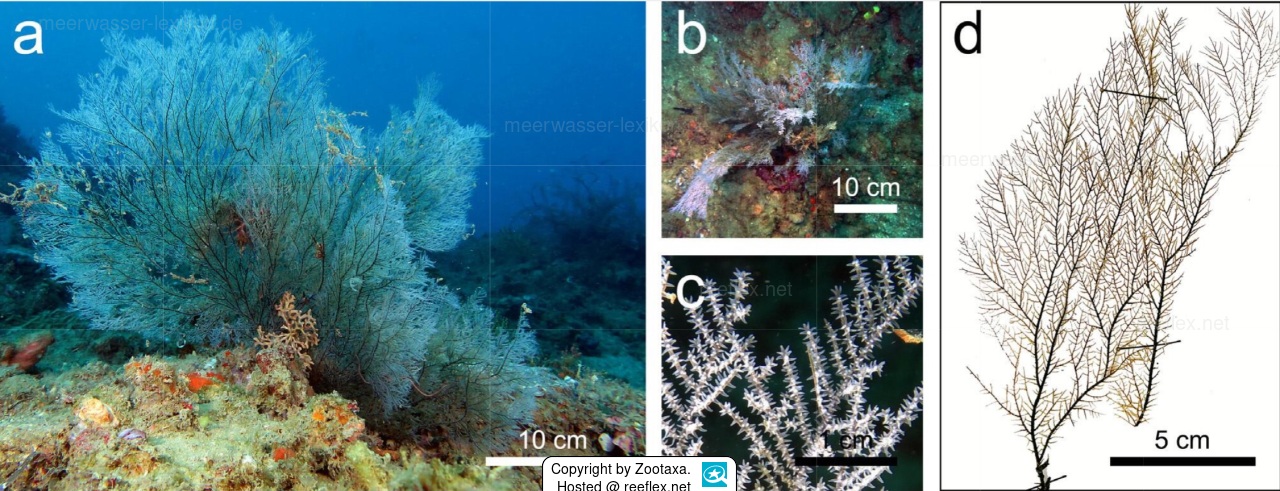Info
Antipatharia, also known as black corals, represent a small group of anthozoan hexacorallians found in all the world's oceans.
They are generally considered a deep-water taxon, yet some of the most diverse communities are known from tropical shallow-water sites
With few exceptions, which are only detailed to a limited extent, black corals from the Indian Ocean and especially from Madagascar and Mauritius are largely unknown.a
One of the few known shallow-water species is Antipathes hypnoides.
Description of Antipathes hypnoides:
The black coral found around Madagascar is a branched, planar and fan-shaped colony with a width of 40 cm and a height of 25 cm, color: white.
The base diameter of the axis is 6 mm and quickly divides into three branches in the same plane.
Some branches grow out of the fan before developing parallel to the plane, creating the impression of superimposed fan-shaped parts.
The general plane of the colony has a front and a back side, but the parts growing parallel to the plane may have their front side facing the front of the colony.
The branches are clearly anterolaterally inserted, and there is a lot of fusion between adjacent branches.
The branches are not strictly bilateral and alternate, as sometimes several branches occur on the same side and rarely opposite or almost opposite.
In some places they almost look like pinnules.
The branches measure up to 8.5 mm, but are usually less than 5 mm long. The branches on the same side of a branch are 1–7 mm apart, with 7–14 branches per cm if you count those on both sides (usually 9–12 per cm). They are attached to the branches at an angle between 30–75°, with an average of 55 ± 10°.
The polyps have a transverse diameter of 0.5–0.6 mm and a distance of 0.2–0.4 mm. Their tentacles are thick and rounded.
They are arranged in a single row on the branches, but can be distributed irregularly on thicker branches, with 9–12 polyps per cm as a rule.
This delicate structure and the fusion of individual branches create an almost impenetrable fan-shaped network in which all kinds of usable zooplankton get caught.
Synonym: Tylopathes hypnoides Brook, 1889 · unaccepted (new combination)
Literature reference:
Terrana, Lucas & Bo, Marzia & Opresko, Dennis & Eeckhaut, Igor. (2020).
Shallow-water black corals (Cnidaria: Anthozoa: Hexacorallia: Antipatharia) from SW Madagascar.
Zootaxa. 4826. 10.11646/zootaxa.4826.1.1.
They are generally considered a deep-water taxon, yet some of the most diverse communities are known from tropical shallow-water sites
With few exceptions, which are only detailed to a limited extent, black corals from the Indian Ocean and especially from Madagascar and Mauritius are largely unknown.a
One of the few known shallow-water species is Antipathes hypnoides.
Description of Antipathes hypnoides:
The black coral found around Madagascar is a branched, planar and fan-shaped colony with a width of 40 cm and a height of 25 cm, color: white.
The base diameter of the axis is 6 mm and quickly divides into three branches in the same plane.
Some branches grow out of the fan before developing parallel to the plane, creating the impression of superimposed fan-shaped parts.
The general plane of the colony has a front and a back side, but the parts growing parallel to the plane may have their front side facing the front of the colony.
The branches are clearly anterolaterally inserted, and there is a lot of fusion between adjacent branches.
The branches are not strictly bilateral and alternate, as sometimes several branches occur on the same side and rarely opposite or almost opposite.
In some places they almost look like pinnules.
The branches measure up to 8.5 mm, but are usually less than 5 mm long. The branches on the same side of a branch are 1–7 mm apart, with 7–14 branches per cm if you count those on both sides (usually 9–12 per cm). They are attached to the branches at an angle between 30–75°, with an average of 55 ± 10°.
The polyps have a transverse diameter of 0.5–0.6 mm and a distance of 0.2–0.4 mm. Their tentacles are thick and rounded.
They are arranged in a single row on the branches, but can be distributed irregularly on thicker branches, with 9–12 polyps per cm as a rule.
This delicate structure and the fusion of individual branches create an almost impenetrable fan-shaped network in which all kinds of usable zooplankton get caught.
Synonym: Tylopathes hypnoides Brook, 1889 · unaccepted (new combination)
Literature reference:
Terrana, Lucas & Bo, Marzia & Opresko, Dennis & Eeckhaut, Igor. (2020).
Shallow-water black corals (Cnidaria: Anthozoa: Hexacorallia: Antipatharia) from SW Madagascar.
Zootaxa. 4826. 10.11646/zootaxa.4826.1.1.







 Zootaxa
Zootaxa
















